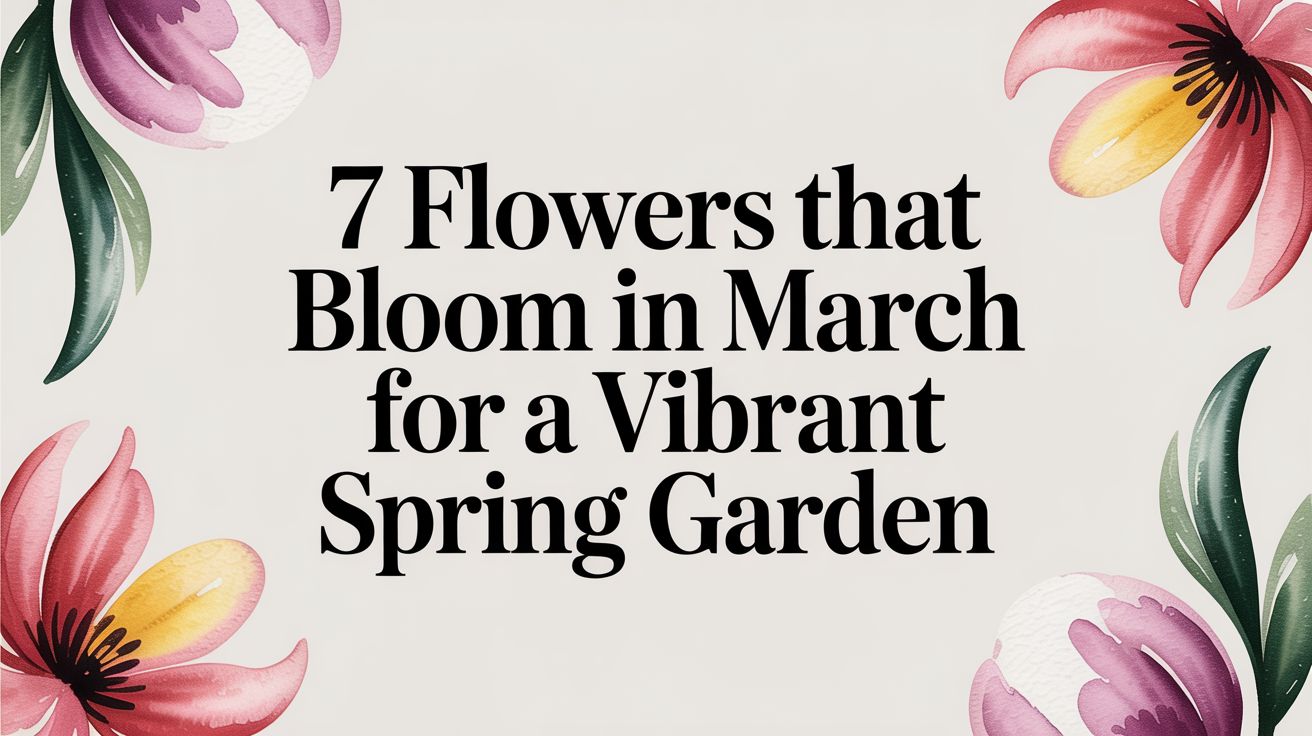As winter's chill recedes, the garden begins to stir with the first vibrant signs of life. March is a month of transformation, where brave blossoms push through the thawing soil to offer a much-needed burst of color. This guide is your curated tour of the most reliable and spectacular flowers that bloom in March, perfect for gardeners eager to kickstart the season or anyone looking to brighten their home with fresh-cut arrangements.
We'll move beyond simple identification, offering deep dives into each flower's unique characteristics, advanced care techniques for stunning displays, and creative design ideas to make your garden a masterpiece. This detailed exploration is designed to provide actionable insights for everyone, from Los Angeles residents planning an event to homeowners wanting to cultivate a vibrant early-spring garden. For those interested in a broader perspective on seasonal flowering patterns, exploring resources on understanding bloom times for various wildflowers can provide excellent foundational knowledge.
Whether you're planning a new garden bed, seeking the perfect stems for an early spring bouquet, or simply want to appreciate the resilience of these early bloomers, this list provides the specific guidance you need. Let's explore the seven floral heroes that define the start of spring and learn exactly how to help them thrive.
1. Daffodils (Narcissus)
Few flowers announce the arrival of spring with the same cheerful authority as the daffodil. As one of the most reliable flowers that bloom in March, the Narcissus genus provides a vibrant and much-needed splash of color after a long winter. These iconic bulbs, known for their trumpet-shaped centers (coronas) surrounded by six petals, are synonymous with renewal and new beginnings. Their brilliant yellows, crisp whites, and warm oranges are a welcome sight in gardens, parks, and floral arrangements across temperate climates.
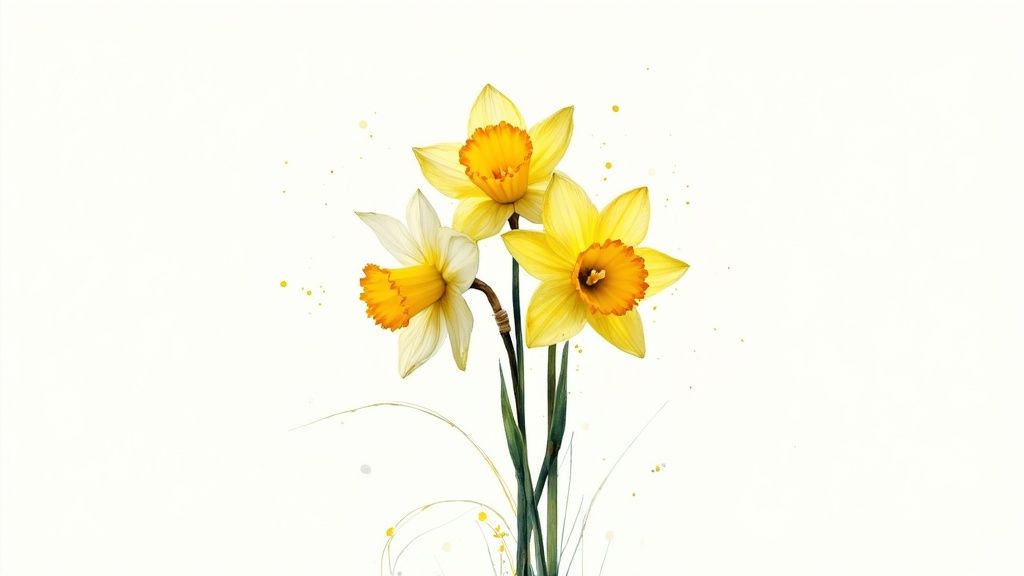
The widespread appeal of daffodils is evident in stunning public displays, from the millions of bulbs at Keukenhof Gardens in the Netherlands to Central Park's Daffodil Hill, which showcases over 20,000 blooms each March. Their hardiness and ease of care make them a favorite for both novice gardeners and seasoned horticulturists.
Growing and Design Tips
To ensure your daffodils bloom reliably in March, proper planting and care are essential. They are an excellent choice for creating bold, naturalized drifts of color in garden beds, borders, or even under deciduous trees.
- Planting: Plant bulbs in the fall, typically from September to November. Dig holes 6-8 inches deep and place bulbs with the pointed end up. For a dramatic effect, plant them in groups of at least 10-12 bulbs rather than in single rows.
- Variety Selection: For guaranteed March blooms, choose early-blooming varieties. Cultivars like 'February Gold', 'Rijnveld's Early Sensation', and the miniature 'Tête-à-Tête' are known to flower at the very start of the season.
- Post-Bloom Care: After the flowers fade, deadhead them to prevent seed formation, which conserves the bulb's energy. Crucially, allow the foliage to die back naturally; do not cut it while it is still green. The leaves are vital for photosynthesis, which fuels the bulb for next year's blooms.
- Styling: In arrangements, daffodils make a stunning statement on their own. Their bright, simple forms are perfect for adding a touch of spring to any home or event. For expert advice on making your cut blooms last, you can explore detailed flower care guides. Learn more about extending the life of your cut daffodils and other fresh flowers.
2. Crocus
Diminutive but mighty, crocuses are often the very first sign that winter's grip is loosening. As some of the earliest flowers that bloom in March, these cup-shaped gems are famous for pushing their way through late-season snow, offering a vibrant and welcome surprise. Ranging in color from deep purples and bright yellows to crisp whites and bicolored stripes, these low-growing corms (often mistaken for bulbs) provide crucial early nectar for awakening pollinators. Their small stature, typically just 3-6 inches tall, makes them perfect for creating carpets of color at the front of borders or in lawns.
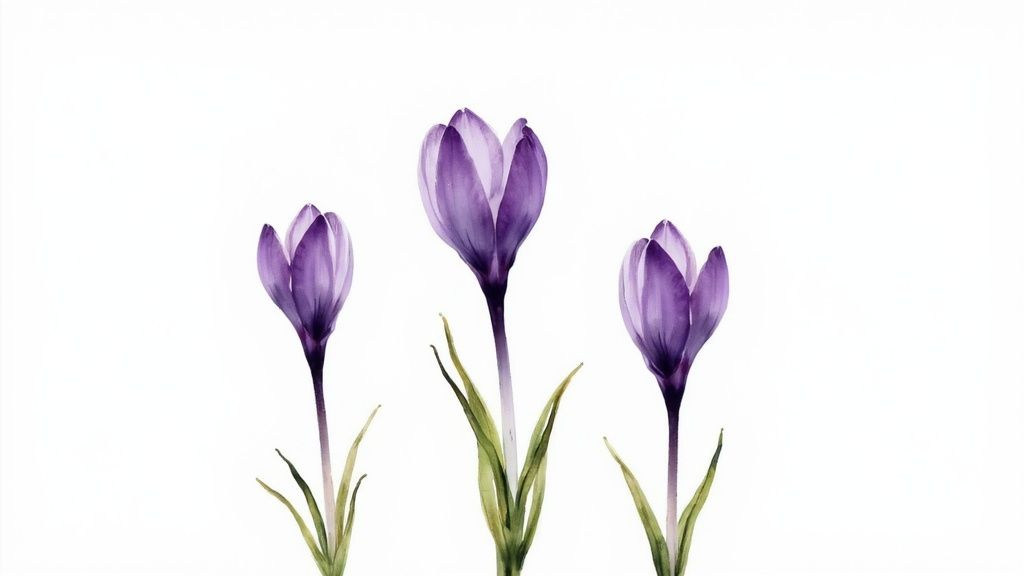
The breathtaking impact of mass crocus plantings can be seen in public gardens worldwide. At Husum Castle in Germany, over four million purple crocuses create a "purple sea" across its meadows each March, while the historic Crocus Lawn at Kew Gardens in London is another celebrated early spring spectacle. These displays showcase the power of this small flower to create a massive visual impact when planted in large numbers.
Growing and Design Tips
To achieve a stunning crocus display in early March, strategic planting in the autumn is key. Their ability to naturalize quickly makes them an excellent investment for long-term, low-maintenance color that returns year after year.
- Planting: Plant corms in the fall, from September to November. Dig holes 3-4 inches deep and space the corms 2-3 inches apart to encourage them to form a dense, natural-looking clump over time.
- Variety Selection: For the earliest possible blooms, select varieties of Snow Crocus (Crocus chrysanthus) or Tommasinianus Crocus (Crocus tommasinianus). Larger Dutch Crocus (Crocus vernus) varieties typically bloom slightly later in March.
- Post-Bloom Care: Similar to daffodils, it is essential to allow the grass-like foliage to die back naturally after the flowers fade. The leaves gather solar energy to fuel the corm for the following year's bloom, so avoid mowing over them until they have turned yellow and withered.
- Styling: Plant crocuses in large, informal drifts in lawns, under deciduous trees, or along walkways for a naturalized woodland effect. Their small size makes them unsuitable for traditional cut flower arrangements, but a small clump dug up and placed in a pot can make a charming, temporary indoor display.
3. Hellebores (Lenten Rose)
For gardeners seeking sophisticated elegance, Hellebores are among the most treasured flowers that bloom in March. Commonly known as the Lenten Rose, these shade-loving perennials defy the late-winter chill with their unique, downward-facing blossoms. Although their name suggests a relation to roses, they are actually part of the buttercup family, Ranunculaceae. Their cup-shaped flowers appear in a subtle, enchanting palette of dusty rose, deep plum, creamy white, chartreuse green, and even near-black, often adorned with delicate speckles or picotee edges.
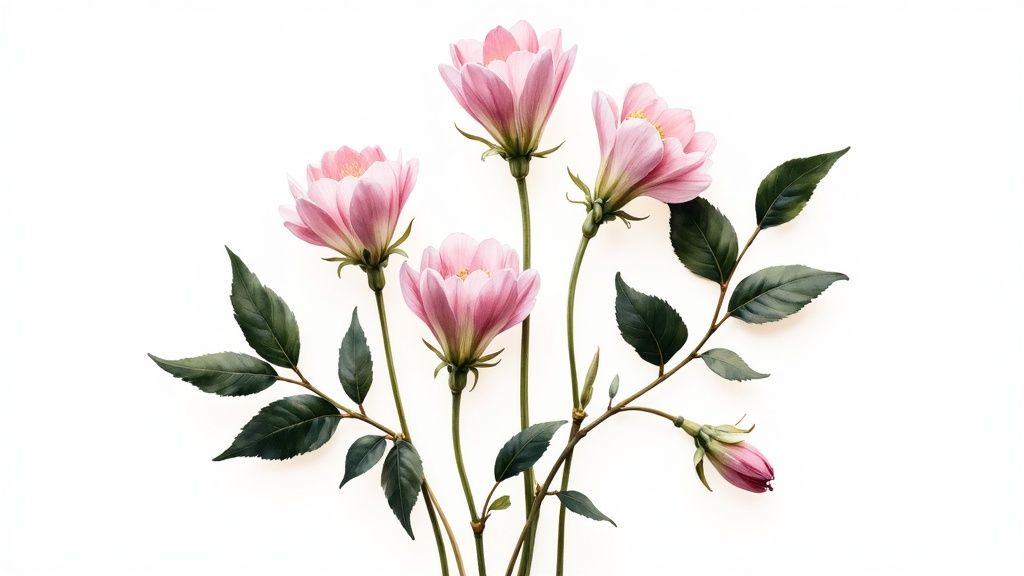
The allure of hellebores is celebrated in renowned woodland gardens worldwide. Great Dixter in the UK features extensive hellebore collections, while Pine Knot Farms in Virginia specializes in developing stunning double-flowered varieties. These long-lasting blooms are prized for their ability to thrive in shady spots where few other plants will flower, providing essential color and structure to the early spring garden. Their leathery, evergreen foliage also offers year-round interest.
Growing and Design Tips
To ensure your hellebores become a reliable March highlight, providing the right conditions is key. They are perfect for naturalizing in woodland settings, underplanting deciduous shrubs, or adding subtle beauty to a shaded perennial border.
- Planting: Plant in fall or early spring in a location with partial to full shade and well-draining soil. Amend the planting area generously with compost or other organic matter to give them the rich conditions they love.
- Variety Selection: For the best garden performance and a wide range of colors, look for hybrid varieties, specifically Helleborus × hybridus. Breeders like Ashwood Nurseries and Terra Nova Nurseries have introduced countless robust and beautiful cultivars.
- Post-Bloom Care: Hellebores are remarkably low-maintenance. In late winter, just before new flower buds emerge, you can trim away the old, tattered foliage from the previous year. This simple step tidies the plant and better showcases the emerging blooms. Always wear gloves when handling them, as the plant's sap can cause skin irritation.
- Styling: To enjoy the nodding blooms indoors, float a few cut flower heads in a shallow bowl of water. This classic presentation allows you to appreciate their intricate details up close and brings a touch of woodland elegance to any tabletop.
4. Primrose (Primula)
For a charming and jewel-toned burst of color at ground level, few plants can rival the primrose. As essential flowers that bloom in March, the Primula genus offers a delightful variety of forms and colors, perfectly suited to wake up a sleepy garden. The name itself, derived from the Latin 'prima rosa' or 'first rose', highlights its role as one of the earliest harbingers of spring. These low-growing perennials, with their characteristic rosettes of crinkled leaves, produce abundant clusters of cheerful flowers in nearly every shade imaginable.
The primrose is a cornerstone of classic cottage garden design, famously featured by legendary horticulturist Gertrude Jekyll in her spring borders at places like Sissinghurst Castle Garden. Their ability to naturalize under trees and along woodland edges creates a magical, storybook feel. The legacy of these flowers is also celebrated by specialist nurseries like Barnhaven Primroses, which has preserved and developed unique, exquisite strains since the 1930s.
Growing and Design Tips
To get the most out of your primroses and ensure a vibrant March display, focus on providing the right conditions. They excel in cool, damp spots, bringing life to shady corners, rock gardens, and container arrangements.
- Planting: Plant in early fall or spring in a location with partial to full shade. Primroses thrive in rich, well-draining soil that remains consistently moist.
- Variety Selection: For classic, low-growing color, choose Primula vulgaris (common primrose). For larger flowers on longer stems, ideal for cutting, try Polyanthus primroses (Primula x polyantha). In wet areas, Japanese Candelabra primroses (Primula japonica) are a stunning choice.
- Ongoing Care: Deadhead spent flowers regularly to encourage a longer blooming period. It is important to keep the soil consistently moist, especially as temperatures rise. Divide established clumps every 2-3 years after flowering to maintain plant health and vigor.
- Styling: Primroses are perfect for underplanting shrubs and deciduous trees or lining a shaded pathway. Their compact size makes them ideal for the front of a border or for creating a "living carpet" of color. When handling the plants, consider wearing gloves, as the foliage can cause skin irritation for some people.
5. Tulips (Early-Blooming Varieties)
While often associated with mid-spring, many early-blooming tulip varieties are reliable flowers that bloom in March, offering their iconic cup-shaped blooms just as the season begins. These cherished bulbs, with a history tracing back to Central Asia and famously embraced by the Dutch, come in nearly every imaginable color. Species tulips and early cultivars provide some of the first and most vibrant displays of the year, symbolizing perfect love and the dawn of a new season. Their elegant form and rich hues make them a cornerstone of the March garden.
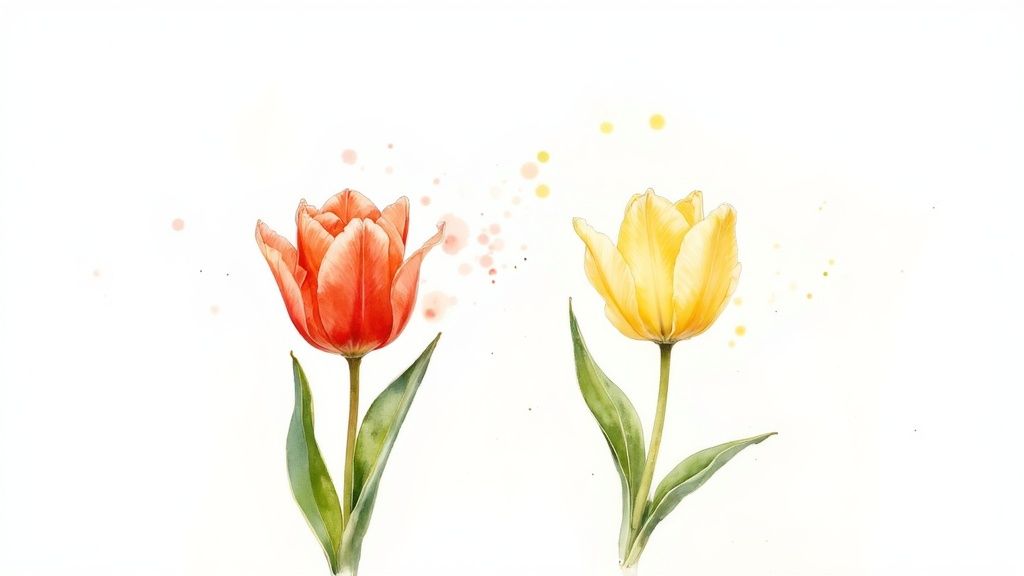
The global love for tulips is showcased in events like the Tulip Time Festival in Holland, Michigan, and the Canadian Tulip Festival in Ottawa, which both feature early varieties in their magnificent March displays. Their versatility allows them to stand out in formal beds, rustic rock gardens, or contemporary containers, proving their enduring appeal for gardeners and floral designers alike.
Growing and Design Tips
To enjoy tulips at the start of spring, selecting the right varieties and following proper planting protocols is key. They are perfect for creating concentrated blocks of color in borders or as striking focal points in planters.
- Planting: For March blooms, plant bulbs in late fall, typically November or December. Plant them 6-8 inches deep with the pointed end facing up. Add a bulb fertilizer or bone meal to the hole to nourish the plant for the upcoming season.
- Variety Selection: Focus on species tulips like T. kaufmanniana, T. greigii, and T. turkestanica, which are known for flowering early and are more likely to naturalize and return each year. Fosteriana (Emperor) tulips are also excellent early bloomers.
- Warm Climates: In warmer zones (8-10), tulips require a period of cold dormancy. You must pre-chill the bulbs in a refrigerator for 6-8 weeks before planting to simulate a cold winter and ensure they flower properly.
- Post-Bloom Care: Deadhead the spent flowers to direct energy back to the bulb. As with daffodils, allow the foliage to turn completely yellow and die back naturally before removing it. This process is essential for storing energy for the next year's growth.
- Styling: Cut tulips bring classic elegance to any space. Their clean lines and vibrant colors make them a versatile choice for arrangements. For more inspiration on using them in your home or for events, you can find many fresh flower arrangement ideas that highlight their beauty.
6. Camellia
The Camellia brings a touch of aristocratic elegance to the late winter landscape, making it one of the most sophisticated flowers that bloom in March. These stunning evergreen shrubs produce exquisite, rose-like blossoms against a backdrop of glossy, dark green leaves, offering both spectacular color and year-round structure. Native to East Asia, their formal beauty has been cherished for centuries, providing a luxurious display when many other plants are still dormant. Their blooms, ranging from pure white and delicate pink to deep crimson, are a symbol of refinement and grace.
The cultural significance of the camellia is vast, famously serving as the signature flower for fashion icon Coco Chanel and inspiring literary works like Alexandre Dumas's La Dame aux Camélias. Renowned gardens, such as Middleton Place in South Carolina and Descanso Gardens in California, dedicate entire forests to showcasing thousands of these magnificent plants, celebrating their timeless appeal and historical importance.
Growing and Design Tips
To cultivate healthy camellias that produce a profusion of March flowers, creating the right acidic and sheltered environment is key. They are ideal as specimen plants, in woodland gardens, or as a breathtaking flowering hedge.
- Planting: Choose a location with partial shade, protecting the plant from the harsh afternoon sun. The soil must be well-draining and acidic (pH 5.5-6.5). Amend heavy soils with organic matter like compost and use sulfur to lower the pH if necessary.
- Variety Selection: While many varieties exist, look for Camellia japonica cultivars or those from the "April" series, which are bred for cold hardiness and reliable late-winter to early-spring blooming.
- Ongoing Care: Maintain consistently moist, but not waterlogged, soil. Mulch with pine needles or pine bark to help retain moisture and maintain soil acidity. Feed with a fertilizer for acid-loving plants right after the blooming season ends.
- Styling: A single, perfect camellia bloom floating in a shallow bowl of water creates a simple yet incredibly elegant centerpiece. Due to their waxy petals and minimal scent, they are excellent for creating structured, classic arrangements. Learn more about the history and cultivation of these amazing plants from the American Camellia Society.
7. Forsythia
Forsythia is the quintessential harbinger of spring, a deciduous shrub that bursts into a spectacular display of golden-yellow flowers well before its leaves appear. As one of the most brilliant flowers that bloom in March, the Forsythia genus provides an electrifying jolt of color to the awakening landscape. Its vigorous, arching branches become completely covered in bell-shaped blossoms, creating a dramatic "spring gold" effect that powerfully signals winter's retreat. This vibrant display often appears when patches of snow may still linger on the ground.
The widespread impact of forsythia is showcased in public spaces like the Brooklyn Botanic Garden, where its golden walks are a major seasonal attraction. In its native East Asia, entire Korean hillsides turn yellow with blooming F. koreana. Its reliability and stunning visual impact make it a cornerstone of landscape design, from heritage gardens in Colonial Williamsburg to modern floral installations for celebratory events.
Growing and Design Tips
To achieve the most dramatic forsythia bloom in March, careful placement and pruning are key. This fast-growing shrub is ideal for creating informal hedges, specimen plantings, or adding a vibrant backdrop to garden borders.
- Planting: For the most prolific flowering, plant forsythia in a location that receives at least six hours of full sun per day. When planting for a hedge, space individual shrubs 6-8 feet apart to allow their natural arching form to develop.
- Pruning: The most critical rule for forsythia is to prune immediately after flowering. Buds for the following spring form on old wood during the summer. Pruning in late summer, fall, or winter will remove these buds and sacrifice your March display. Use renewal pruning by cutting about one-third of the oldest, thickest stems down to the ground each year.
- Variety Selection: In colder climates (Zone 4), choose exceptionally hardy cultivars like 'Meadowlark' or 'Northern Gold' to ensure flower buds survive the winter.
- Styling: Cut bare branches in late January or February and place them in a vase of water indoors to "force" an early bloom. The delicate yellow blossoms on arching stems are perfect for creating airy, naturalistic arrangements and can be a stunning, minimalist addition to spring wedding decor. Discover how these branches can elevate event designs by exploring seasonal wedding floral options.
March Blooming Flowers Comparison
| Plant | Implementation Complexity | Resource Requirements | Expected Outcomes | Ideal Use Cases | Key Advantages |
|---|---|---|---|---|---|
| Daffodils (Narcissus) | Low - easy to plant bulbs in fall, minimal care | Moderate - well-draining soil, full to partial sun | Reliable early spring blooms lasting 2-3 weeks | Naturalizing lawns, meadows, early spring color | Deer resistant, low maintenance, wide color variety |
| Crocus | Low - simple planting but protective measures needed | Low - well-draining soil, full to partial sun | Very early blooms (1-2 weeks), small size | Lawns, rock gardens, borders, early pollinator support | Earliest bloomers, drought tolerant, affordable |
| Hellebores (Lenten Rose) | Moderate - requires shade and soil prep, slower to establish | Moderate - rich, moist soil, partial to full shade | Long bloom period (6-8+ weeks), evergreen foliage | Shade gardens, woodland plantings | Shade tolerant, long-lasting flowers, disease resistant |
| Primrose (Primula) | Moderate - consistent moisture and protection needed | Moderate - rich, moist soil, partial to full shade | Prolific blooms in early spring, attracts pollinators | Containers, woodland gardens, cottage gardens | Wide color range, early pollinator attraction |
| Tulips (Early-Blooming Varieties) | Moderate - bulbs must be planted correctly, care for deer protection | Moderate - well-draining soil, full sun | Spectacular, early vibrant blooms lasting ~1 week | Formal gardens, cut flowers, spring displays | Wide color range, excellent cut flowers, early bloom |
| Camellia | High - slow growing, soil acidification needed | High - acidic, rich soil, partial shade | Long-lasting blooms, shrubs 6-12+ ft tall | Woodland gardens, specimen shrubs, hedges | Evergreen, deer resistant, shade tolerant |
| Forsythia | Low - very easy to grow and maintain | Low - adaptable soil, full sun to partial shade | Showy bright yellow bloom for 1-2 weeks | Hedging, quick screening, spring color accents | Fast growing, cold hardy, excellent cut branches |
Bringing March's Beauty into Your Home and Garden
As the final traces of winter recede, the emergence of March’s earliest flowers serves as a vibrant and welcome promise of the brighter days ahead. From the cheerful, sun-like faces of Daffodils and Forsythia to the quiet elegance of Hellebores and Camellias, each bloom offers a unique opportunity to infuse your landscape and living spaces with the season's first wave of color and life. This guide has explored not just which flowers to plant, but how to strategically combine them for a garden that delivers a continuous, evolving display of beauty throughout the month.
The key takeaway is that a stunning March garden is born from thoughtful planning. It’s about creating layers of interest and a succession of blooms. Imagine the low-growing, jewel-toned Crocuses carpeting the ground beneath the architectural stems of early-blooming Tulips, or the delicate Primroses providing a soft border for the more dramatic, evergreen foliage of a Camellia shrub. This approach transforms a simple collection of plants into a cohesive and dynamic ecosystem of color and texture.
Actionable Steps for a Vibrant March Garden
To translate this inspiration into reality, here are your next steps for cultivating a garden that truly celebrates the arrival of spring:
- Plan for Succession: Review the bloom times for each flower. Plant bulbs like Crocus and Daffodils in clusters, knowing the crocuses will fade just as the daffodils reach their peak. This ensures your garden never has a dull moment.
- Embrace Indoor Styling: Don't limit the beauty to the outdoors. A few clipped branches of Forsythia placed in a tall vase will bring a dramatic burst of yellow indoors, while a simple posy of Hellebores can add sophisticated charm to a side table.
- Combine Textures and Heights: Pair the glossy, broad leaves of Camellias with the delicate, nodding heads of Daffodils. Use the upright growth of early Tulips to create vertical interest behind shorter Primroses. This creates a visually rich and engaging garden design.
- Deepen Your Knowledge: The success of these early bloomers often depends on preparing the soil and understanding their specific light and water needs. To further enhance your gardening success and learn best practices for cultivating beautiful spring displays, explore essential gardening tips.
By implementing these strategies, you are not just planting flowers; you are curating an experience. You are designing a space that evolves with the season, offering new delights each week. The effort invested now pays dividends in the form of a breathtaking landscape that serves as a powerful antidote to winter's gray and a joyful welcome to the energy of spring. Let the diverse and resilient flowers that bloom in March inspire you to create something truly special.
Ready to bring the curated beauty of March blooms into your home or event without the wait? For Los Angeles residents, Fiore specializes in crafting breathtaking floral arrangements using the freshest seasonal flowers. Explore our designs and let us deliver the art of spring directly to your door.
